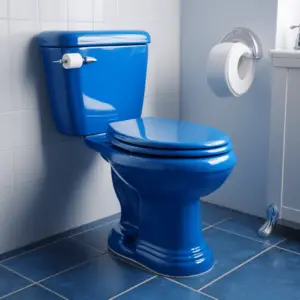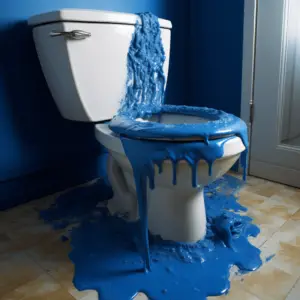Blue Toilet Water Issues Is your toilet bowl water turning bluish whenever you flush it? Never mind because this issue happens pretty often to many people. Bluewater is caused by cleaning substances, some of which are dispensed via a tablet each time you flush your toilet.
Table of Contents
How To Get Rid Of Blue Toilet Water: How to Fix it

This guide will inform you of the causes, the facts about blue water, ways to get rid of blue water, and other tips on the topic. Let’s get started.
Why is the Toilet Water Blue?
Blue Toilet Tablets
Who doesn’t love the convenience of the blue tablets in our toilet tanks? The toilet tablet works its magic as you use your toilet as usual. It kills the pink mold while giving you such a clean visual pat-on-the-back.
Most of these tablets are in a blue dye purposely to turn the water blue as they clean the toilet leaving it fresh and reassuring the homeowner of its effectiveness.
However, frequent use of the blue toilet tablets eventually eats around your toilet seals, parts, and plumbing like the flush valve. Excessive use of the tablets exposes your pipes to excessive chlorine levels.
As a result, small unnoticeable leaks begin building up, and over time it snowballs into something inconvenient and expensive.
Stains from the blue dye develop unevenly, yielding a solid unnatural hue, and the only remedy is to change the products.
Copper Piping Corrosion
Highly common in the old houses from the back of the 1900s, copper pipes still show in the old and new plumbing systems. They transport nonpotable water.
Copper pipes are durable because they can withstand high water pressure and hot water, hindering corrosion, but not entirely. It corrodes when subjected to high levels of oxygen and chlorine, changing the composition of the material.
High oxygen levels in the copper pipe cause the toilet water to turn blue, leaving rustic blue stains and muted than the bright hue of blue dye.
You can troubleshoot high levels of copper if you realize blue stuff in different toilets in your house or if your neighbor experiences the same issue.
It is important to note that the orange-tinted, rusty stains do not necessarily mean they are due to corrosion but indicate hard water stains from your water supply to your home containing very high mineral content.
What Other Factors Can Make My Toilet Water Blue?
Mainly, water treatment causes the blue color. When there is a risk of water contamination, some municipalities add extra chlorine to the water during hot weather. Once such water mixes with chemicals in your toilet bowl, it turns the water bluish.
Another cause of blue toilet water may be a dye that tracks the water flow through the pipes, and if your toilet bowl has a blue stain, it is because the dye has built up over time and has saturated.
In some cases, using blue cleaning products without proper rinsing may cause bluish during flushing as the first person to visit the toilet.
How to Get Rid Of Blue Toilet Water?
Clean Using Sodium Borate and Vinegar
Get Sodium borate and vinegar
¼ of borax in the toilet bowl and stir with a toilet brush
Let a cup of vinegar sit in the bowl for approximately 20 minutes
Using a toilet brush, scrub the bowl to remove any leftover discoloration
Flush the toilet to clean out the chemicals thoroughly until you the water is sparkling clear
Use Water Filters
It may be difficult to prevent the oxidation process in old, rusty pipes; filters can aid improve the water condition by removing copper residue from the water before it leaves the toilet flush, hindering it from getting an unusual color.
Use different filters to filter your water: activated carbon, chlorine, ion exchange, and fluoride filters. These filters will assist in removing copper from your tap water and safeguard you from other contaminants.
Prevent Corrosion
The lifespan of your pipes depends on plumbing maintenance and cleaning regime. Here are some ways you can prevent copper pipe corrosion:
- Lower the water temperatures
- Adjust water pH levels
- Lower water pressures
- Insulate your pipes
- Resolve clogs and leaks quickly
- Reduce the use of chemicals in your cleaning and maintenance
- Clean mildew and corrosion of the lines and the closed area regularly
Replace Your Home Plumbing

This option is permanent as it addresses the underlying cause-corroded drain pipes. You can replace your plumbing with a modern plumbing system that uses plastic parts. Although this method is highly costly, you need to strategize before acting.
Is The Blue Water Safe In Toilet?
Among the several options available to clean the toilet, one of the most popular is changing the color water! Sure, it is excellent due to its aesthetic appeal. However, the blue water is causing more harm than good, and this is why:
Corrodes Parts
Over time, the blue water will corrode the flush valve weakening your flushes upon each use. Continuous use of the tablet will lead to frequent replacement of the flush valve, which adds to your expense.
Harmful Chemicals
The blue toilet tablets are full of toxic chemicals. Yes, you may thoroughly clean your bathroom as a whole with chemical-based cleaners- the blue toilet tablet will constantly disperse chemicals, negatively impacting your indoor air quality all day.
Consequently, creating havoc on your plumbing system over time and bringing down its quality as the tablets contain chlorine.
Causes Blockages
Another defect of a blue tablet is the change of forming a blockage, mainly obstructing the flapper. As a result, there is a lot of toilet water wastage since the valve is left in and won’t cease to stop.
A blocked flapper allows water to flow freely for quite some time.
How Can You Remove The Blue Copper Stain From The Toilet Bowl?
In a bowl, mix 1 cup of distilled white vinegar and 1 cup of table salt then:
- Wear your toilet cleaning gloves
- First, dip the sponge into the prepared mixture
- Using the damp sponge, wipe the copper stains
- Pull the chain and examine the surrounding area
- Vinegar won’t affect your toilet tank, bowl, or internal components.
- Scrub the mixture thoroughly on your toilet’s inside and outside surfaces to clear the residue.
Tip: The blue ring will eventually reappear if your water supply contains significant copper. Therefore, use ammonia and water solution every few months to remove the ring and other blue stains to prevent them from building up to become an eyesore.
Getting rid of the blue toilet water can be a hassle. Nevertheless, there are ways to remove its defects, like the blue ring on the bowl, as already discussed above. To permanently prevent discoloration, change the rusted drain pipes.
To naturally deodorize your toilet, add 3 cups of vinegar to the tank and let it settle for 30 minutes before flushing.
